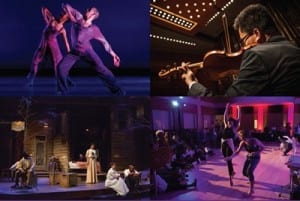NCAR study identifies the key differences between culturally specific organizations and their mainstream peers and calls for a more equitable measurement of performance
The National Center for Arts Research (NCAR) at Southern Methodist University today released a white paper that examines the distinguishing characteristics of arts organizations that primarily serve Asian American, African American, and Hispanic/Latino communities.
The study is designed to provide insights, based on measurable data, about the operating contexts and unique challenges that these organizations face. Co-authored with Andrea Louie, Executive Director, Asian American Arts Alliance, and Zenetta Drew, Executive Director, Dallas Black Dance Theatre, the goal of the white paper is to provide a more nuanced understanding of culturally specific organizations and to help establish a more equitable measure of their performance.
Inspired by the DeVos Institute’s 2015 publication “Diversity in the Arts: The Past, Present and Future of African American and Latino Museums, Dance Companies, and Theater Companies,” NCAR’s paper responds to two key aspects of the DeVos Institute’s findings: first, that arts organizations of color are in general smaller and “far less secure” than their mainstream counterparts; and second, that funders might see greater results by providing larger grants to a smaller number of “effective” organizations, rather than continuing to fund a larger number of organizations through smaller grants.
Based on its research, NCAR found that culturally specific arts organizations are not disproportionately smaller than their mainstream peers. Taking into account their sector and age, the data shows that they are generally younger and therefore at a different stage in their evolution than mainstream organizations.
NCAR argues that the funding model proposed by DeVos would be detrimental to the cultural ecology, as it could effectively reduce the overall number of smaller organizations and therefore diminish the level of diversity, dynamism, and innovation in the field. NCAR calls for a deeper understanding of culturally specific organizations before significantly altering or abandoning their funding.
“We recognize that culturally specific organizations have particular characteristics that should be understood for what they are, neither good nor bad nor a sign of ineffectiveness but simply a different starting point,” said Zannie Voss, director at NCAR. “With this study, we want to reframe how we assess the performance of these organizations by identifying the differences in their operating contexts and by establishing a more precise framework of what expected performance should look like, rooted in evidence-based research.”
NCAR’s study examined the operating characteristics of arts organizations that primarily serve African Americans, Asian Americans, or Hispanics/Latinos as compared to their more mainstream counterparts, and examined whether they perform significantly differently on a variety of metrics. An analysis of data from a large sample of organizations across 12 different arts and culture sectors produced several other key findings:
- Culturally specific organizations are more prevalent in sectors that have lower average budget size (e.g., community-based arts, arts education), and less prevalent in sectors with larger budgets (e.g., museums, opera companies, performing arts centers).
- Culturally specific organizations have similarly sized budgets and physical facilities as mainstream organizations but spend less on marketing, earn less from subscriptions, and have lower trustee giving; however, they attract a higher level of support from government sources.
These organizations also demonstrate performance characteristics that distinguish them from one another (as well as their mainstream counterparts). More specifically:
- Asian American organizations generate more attendance using fewer resources but also attract a lower level of support from all sources except for government.
- African American organizations tend to have fewer programmatic offerings that generate lower annual attendance and program revenue but more contributed revenue, especially from individuals, foundations and corporations.
- Hispanic/Latino organizations tend to have a higher number of programmatic offerings, full-time employees, and development expenses, which generate higher overall contributed support, especially from corporations and foundations, but lower program revenue and lower individual giving.
In order to create the level playing field it seeks to establish, NCAR’s study controlled for a number of factors:
Inherent differences within the arts and culture sector; e.g., data shows that art museums have higher attendance rates than do dance companies.
Organizational characteristics, especially fundamental characteristics that are difficult to change in the short term but can influence performance attributes of an organization, such as size of the physical facility and organizational age.
The characteristics of the community where the organizations operate; e.g., New York City has a larger population with higher average income and tourist visits than most U.S. cities, but also more competition for arts and culture consumers.
“Diversity in the arts is a multifaceted and complex issue. As an academic institution that seeks to educate future leaders in the arts, we are proud to make this contribution to the broader field discussion on diversity,” said Sam Holland, dean of the Meadows School of the Arts at SMU. “NCAR was established to catalyze new and informed thinking about important issues in the arts with a data-driven approach. It is our hope that the compelling insights set out by this study will help support the sustainability of a dynamic and diverse arts and cultural community around the country.”
